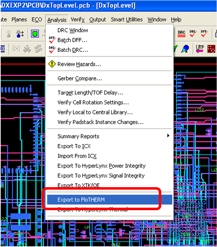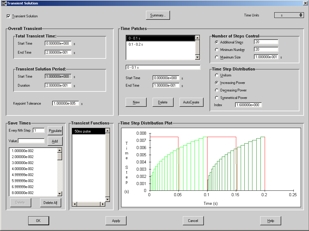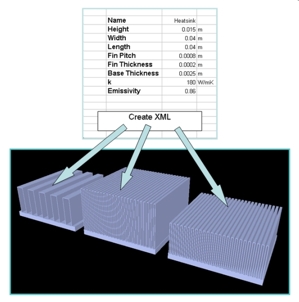We Love FloTHERM – 8 Reasons to Upgrade to V9.1
Here at the Mechanical Analysis Department we love FloTHERM and we love developing FloTHERM to ensure it keeps up with the needs and follows the trends of the electronic thermal simulation market. The latest release of FloTHERM, V9.1, has a wealth of features and benefits that continues to ensure it’s position as the #1 CFD based software tool used for such purposes. Here are the top 8…
 Direct interface to Expedition PCB. Supplied via a free add-in, all the data required for a detailed thermal PCB model can be exported from Expedition PCB for subsequent import into FloTHERM via the FloEDA interface window. Circumventing the well known deficiencies of the IDF file format, the exported .floeda file contains everything IDF does plus a description of the layer stack-up as well as a full description of the metallic distribution on all conducting and dielectric layers. Using the unique ‘image processing’ capabilities in FloEDA, an efficient thermal conductivity map can be created to accurately capture the effects of differing thermal resistances the heat experiences as it passes through the PCB.
Direct interface to Expedition PCB. Supplied via a free add-in, all the data required for a detailed thermal PCB model can be exported from Expedition PCB for subsequent import into FloTHERM via the FloEDA interface window. Circumventing the well known deficiencies of the IDF file format, the exported .floeda file contains everything IDF does plus a description of the layer stack-up as well as a full description of the metallic distribution on all conducting and dielectric layers. Using the unique ‘image processing’ capabilities in FloEDA, an efficient thermal conductivity map can be created to accurately capture the effects of differing thermal resistances the heat experiences as it passes through the PCB.
 Painless transient model definitions. The transient grid dialog has been completely reworked to present all capabilities required to define a transient model in one place. A ‘one stop shop’ that will not leave you feeling frustrated at having to dig around the gui looking for each individual transient model setup parameter. Automatically created time grid patches, the ability to overlay the transient functions on the time grid, one button to save the results at all intermediate time steps, applying one change to multiple selected time patches, all conspiring to make your simulation life easier.
Painless transient model definitions. The transient grid dialog has been completely reworked to present all capabilities required to define a transient model in one place. A ‘one stop shop’ that will not leave you feeling frustrated at having to dig around the gui looking for each individual transient model setup parameter. Automatically created time grid patches, the ability to overlay the transient functions on the time grid, one button to save the results at all intermediate time steps, applying one change to multiple selected time patches, all conspiring to make your simulation life easier.
- Shift select in the Project Manager. At the time of implementation it was the #1 voted request on the Mentor IDEAS for Mechanical site. Taken for granted on standard operating systems, you can now select a range of objects in the Project Manager node tree in just 2 clicks.
- Ability to select objects of differing type. The historic restriction on not being able to select parts/assemblies, monitor points, regions and the solution domain at the same time has now been lifted. You can now move say cuboids with internal monitor points at the same time, you can select the solution domain and the root assembly at the same time then align them in the Drawing Board, colocate regions and objects. It’s often the simplest things that have the biggest effect!
 Conducting fan hubs. Fan hubs used to be considered adiabatic, that was then… Now they conduct heat and attain realistic surface temperatures. Also, the amount of consumed power converted into thermally dissipated power is determined by the operating fan efficiency which in turn is derived from its fan curve operating point.
Conducting fan hubs. Fan hubs used to be considered adiabatic, that was then… Now they conduct heat and attain realistic surface temperatures. Also, the amount of consumed power converted into thermally dissipated power is determined by the operating fan efficiency which in turn is derived from its fan curve operating point.
- Power as a non-linear function of temperature. As temperature dependent leakage effects become more apparent at sub 90 nm scales the total power dissipation of an IC will itself vary with its operating temperature. The source attribute in FloTHERM now has the ability to define, or to import, a power dissipation vs. temperature curve.
- Bottleneck (Bn) and Shortcut Opportunity (Sc) fields. An industry first, patent pending invention that allows, for the first time, to visualise where thermal bottlenecks exists in your system by presenting the Bn field. Relieving high value bottlenecks through a redesign will allow the heat to leave the system more readily and result in a reduction of temperature rises. Similarly, the Sc field shows where the insertion of a new heat flow path would allow the heat to reach the ambient more quickly, again reducing temperature rises. Check out this 30 minute recorded webinar that goes into the theory and shows some applications.
 New XML format and Icepak converter. We have created an XML schema to allow geometry and attribute data to be written to file by user created scripts for subsequent unlicensed import into FloTHERM. So, if there is a class of geometry that you wish to create variations of often then write your own XML generating macro. An example of a folded fin heatsink generator can be found here on SupportNet. In addition we are also supplying a utility to convert Icepak model data into this XML format for subsequent import into FloTHERM. One less reason for not using FloTHERM.
New XML format and Icepak converter. We have created an XML schema to allow geometry and attribute data to be written to file by user created scripts for subsequent unlicensed import into FloTHERM. So, if there is a class of geometry that you wish to create variations of often then write your own XML generating macro. An example of a folded fin heatsink generator can be found here on SupportNet. In addition we are also supplying a utility to convert Icepak model data into this XML format for subsequent import into FloTHERM. One less reason for not using FloTHERM.
With the release of V9.1 we can prove that we’ve come good on our promise to support the IDEAS site. We’ve implemented 4 of the top 10 voted requests and 14 IDEAS posted requests in total. It’s also looking like we’re going to beat those metrics for the next FloTHERM release as well.
OK, now for the serious stuff… If you’ve read this far hopefully you’re interested in FloTHERM. However if, like us here in the Mechanical Analysis Division, you simply LOVE FloTHERM then why not demonstrate your affection by joining the ‘We Love FloTHERM’ Facebook group. Just for fun of course 🙂
5th November 2010, Ross-on-Wye


